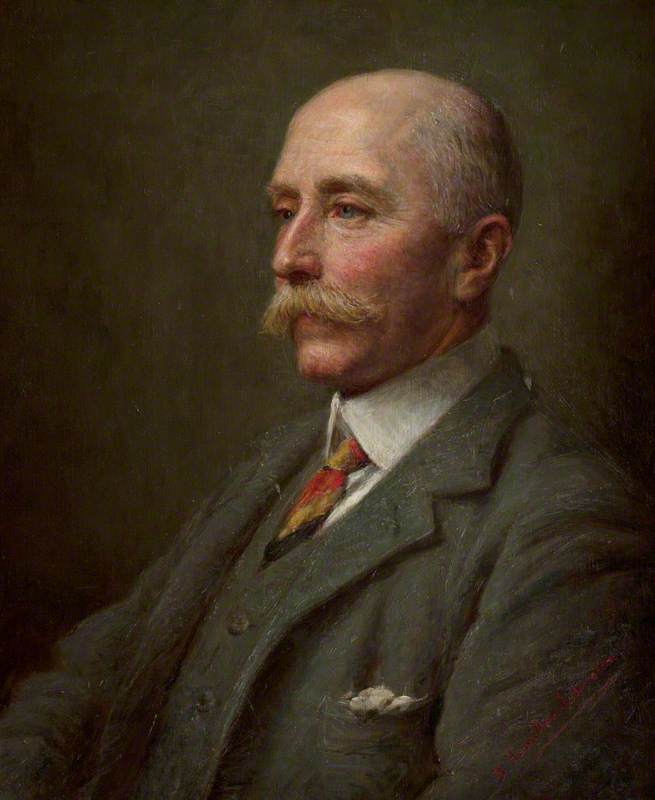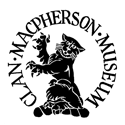
Albert Macpherson of Cluny (1854–1932) c.1900–1925
Bessie Hamilton-Johnston (1860–1943)
Clan Macpherson Museum
A very competent amateur painter of oil portraits of people whom she mainly appears to have known, of occasional copies of historical works and of watercolours, though none of the last have yet been located. The youngest daughter of Patrick Robertson (1828–1883) and his wife Amelia Ann (née Maynard), she was born on 15th September 1860 at Cleveland Square, Westminster, and baptised at St Mary’s, Paddington Green, on 6th October. Her parents had married in 1851. Her father was an army lieutenant-colonel at the time of her birth and himself son of a distinguished Scottish lawyer. Her mother was born in the Cape Province of South Africa as daughter of Charles Maynard, a Cape merchant. They presumably met there when Patrick Robertson was a junior officer in the Capetown Rifles from 1848, before serving with distinction in the Crimean War as ADC to General Sir Eyre Coote. When his uncle, General Hugh Ross, died on 24th June 1864, he inherited the latter’s Scottish property and changed his surname to Robertson-Ross.
On 2nd June 1888 Bessie, then of 31 Gloucester Road, Kensington, married there to Augustus Hamilton-Johnston (b.c.1849), eldest son of the late Captain James Charles Glen Johnston, RN. At the 1891 census the couple were living at 33, Egerton Gardens, Kensington, with their first two children, Douglas aged one and Dorothy aged six months. On 2nd April 1896, at 22, Draycott Place, London, Bessie had another son, Ewen Colquhoun Robertson Hamilton-Johnston and in 1901 the family was at 17, Cadogan Gardens, Chelsea, with the two younger children and seven servants: Douglas was presumably away at school (Charterhouse and later Westminster).
Bessie exhibited four works at the Society of Women Artists from Cadogan Gardens, 1906–1910, though a label on a privately owned portrait of the actress Nell Toller (painted before 1910) suggests she had studio space at 1, Eldon Road and subsequently ‘Victoria Road W.’ about this time. In 1907 she shared an exhibition with a Colonel Whipple and his wife (he a landscape watercolourist, she a jeweller) at the Bruton Gallery, London. A Morning Post review (24th June) complimented her portraiture technique and ability to capture characterful likeness, also noting some landscape oils of St Ives (presumably Cornwall). Examples of society wedding notices between 1898 and 1921 also suggest that she gave her own pictures as wedding presents, including copies after Greuze (1898) and Raeburn (1906). She is recorded as doing a posthumous portrait of her father that was exhibited at the Royal Scottish Academy in 1885 (the only one recorded under her maiden name), and one of her husband was in the Bruton show of 1907. She also appears to have occasionally sold her watercolours at charity fundraising events.
By the time of the 1911 census, the Hamilton-Johnstons were living at ‘Bandirran’, Pangbourne, Berkshire, with three servants. Augustus, then 61, was described as ‘a retired cattle rancher’ and their three children were not present. Both sons were killed in the First World War, Douglas as an acting-major in the Black Watch in Mesopotamia, in January 1916. Ewen, a lieutenant in the King’s Own Scottish Borderers, died on the Western Front on 1st September 1918 and is buried at Buissy. The family address was then 11, Park Mansions, Kensington, but by 1921 his parents had moved to Fairacre, Axminster, Devon, where his father died aged 71 on 7th November 1921, leaving estate worth about £220,000 in today’s terms (£7,561–14s–2d at probate).
Current evidence suggests Mrs Hamilton-Johnston did not paint in oils – or at least paint oil portraits – after the First World War, in which the death of both their sons must have had a great effect on both parents and the boys’ sister. She died at the Cortlands Hotel, Hove, Sussex, on 18th November 1943, leaving estate valued at £3,687–0s–9d.
Summarised from Art UK’s Art Detective discussion ‘Can you tell us more about the artist Bessie Hamilton Johnston?’. The discussion identifies the Scottish sitter (above) as a stockbroker and notable amateur cricketer who played for both the MCC c.1887–1901 and ‘I Zingari’, c.1901–1912. He is shown wearing a Masonic tie.
Text source: Art Detective
